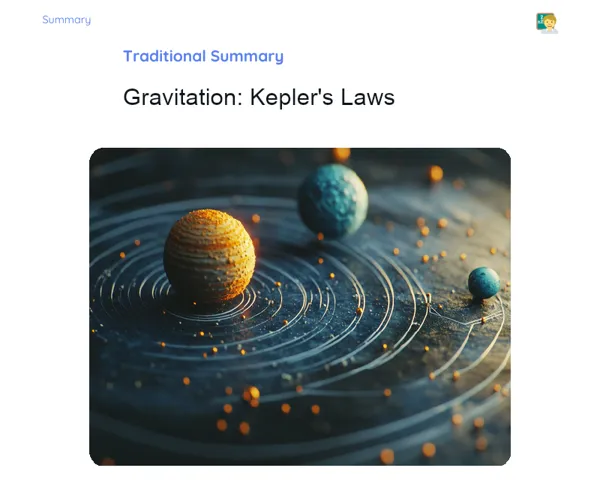Objectives
1. 🌍 Understand and calculate the gravitational force of the Earth in relation to its radius, using the Universal Gravitation formula.
2. 🚀 Apply the knowledge of mass, radius, and the gravitational constant to calculate gravity on other planets, enhancing analytical and problem-solving skills.
Contextualization
Did you know gravity isn't just a theory? It plays a vital role in our everyday lives! From the simple fall of an apple to the intricate paths of satellites orbiting our planet, gravity holds everything in place. This powerful force is crucial; without it, life as we know it would be impossible. By understanding gravitation, we not only make sense of natural events but also support advancements in space technology and modern communication.
Important Topics
Universal Gravitation Formula
Isaac Newton's Universal Gravitation formula explains the attraction between two masses, m1 and m2, separated by a distance r. The formula is F = G * (m1 * m2) / r^2, where F represents the gravitational force, G is the gravitational constant, m1 and m2 are the respective masses, and r is the distance between the centers of mass.
-
The gravitational force decreases as the distance between the objects increases, following the inverse square law.
-
The gravitational constant (G) is a universal value defining the strength of gravitational force between masses of 1 kg separated by 1 meter.
-
This formula is essential for understanding and calculating gravity across various celestial bodies including planets and stars.
Calculating Gravity on Other Planets
To determine gravity on other planets, we use the gravitational acceleration formula (g = G * M / r^2), where M is the planet's mass and r is its radius. This helps us understand how gravity differs across planets due to their unique masses and sizes.
-
Gravitational acceleration increases on planets that have larger mass combined with smaller radius.
-
These computations are crucial for space missions, as they inform us about object weight and the force required to maintain stable orbits.
-
Knowledge of these calculations is vital for future colonization efforts, where gravity impacts human life and the environment.
Practical Applications of Gravitation
Gravity has many real-world applications, from calculating the paths of satellites and spacecrafts to predicting cosmic events like eclipses and tides. Moreover, an understanding of gravity is necessary for developing technologies that rely on it, including weighing scales.
-
In the aerospace sector, grasping gravity is essential for designing vehicles that need to overcome Earth's gravitational pull.
-
Studying gravitational effects is necessary for predicting natural disasters, such as tsunamis and volcanic activity.
-
In communication tech, precise gravity calculations are critical for satellite positioning and signal transmission.
Key Terms
-
Gravitation: The attractive force between all bodies with mass in the universe.
-
Gravitational Force: The force with which Earth attracts objects toward itself.
-
Gravitational Acceleration: How quickly an object’s speed changes due to gravity.
-
Gravitational Constant (G): A constant in the universal gravitation formula, measured in cubic meters per kilogram per second squared (m³/kg/s²).
For Reflection
-
How does gravity affect planet and star formation and evolution?
-
What if the gravitational force between objects did not follow the inverse square law?
-
In what ways might manipulating gravity influence future space exploration and life on Earth?
Important Conclusions
-
Today, we delved into the interesting world of gravitation, learning about the Universal Gravitation formula and how it governs everything from a falling apple to the orbital paths of satellites around our planet.
-
We explored how to calculate the Earth's gravitational force and gravity on other planets, applying these concepts through practical activities that enriched our understanding.
-
We also looked at the practical aspects of gravitation, from aerospace applications to natural event predictions, highlighting the importance of gravity in our lives and modern technology.
To Exercise Knowledge
- Gravitational Calculator: Use the universal gravitation formula to compute the gravitational force between you and various objects in your home. 2. Planet Model Project: Design a model of an imaginary planet with specific features and calculate its gravity. 3. Gravitational Diary: For one week, document instances where gravity influenced your daily observations or activities, reflecting on its significance.
Challenge
🌌 Space Explorer Challenge: Pick a planet from our solar system and create a 'survival kit' suited for its gravity. Include useful items for living in that gravitational environment and explain why they are essential. Present your kit as a drawing or video!
Study Tips
-
Utilize gravity simulation apps to visualize how factors like mass and radius impact gravity on various planets.
-
Engage with your peers to discuss the applications of gravitation in fields like engineering and astronomy.
-
Watch documentaries or read articles about recent space missions, focusing on how knowledge of gravitation was vital for their success.



